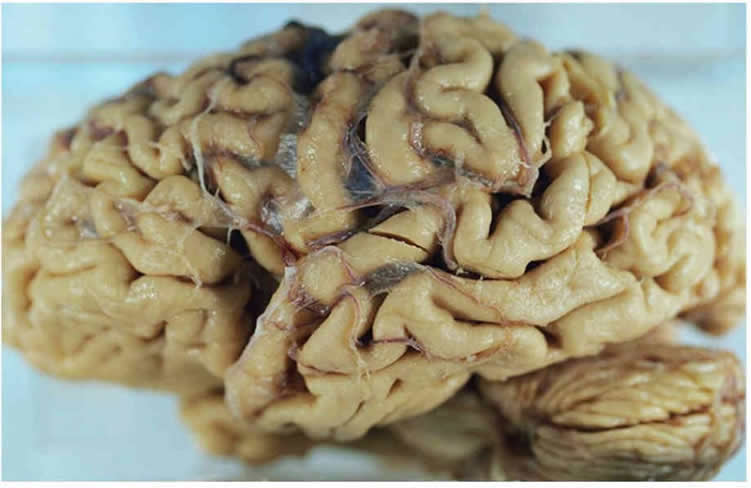Summary: Researchers report an inflammatory mechanism within the brain’s immune system may drive the progression of Alzheimer’s disease.
Source: DZNE.
According to a study by scientists of the German Center for Neurodegenerative Diseases (DZNE) and the University of Bonn now published in the journal “Nature”, inflammatory mechanisms caused by the brain’s immune system drive the progression of Alzheimer’s disease. These findings, which rely on a series of laboratory experiments, provide new insights into pathogenetic mechanisms that are believed to hold potential for tackling Alzheimer’s before symptoms manifest. The researchers envision that one day this may lead to new ways of treatment. Further institutions both from Europe and the US also contributed to the current results.
Alzheimer’s disease is a devastating neurodegenerative condition ultimately leading to dementia. An effective treatment does not yet exist. The disease is associated with the aberrant aggregation of small proteins called “Amyloid-beta” (Abeta) that accumulate in the brain and appear to harm neurons. In recent years, studies revealed that deposits of Abeta, known as “plaques”, trigger inflammatory mechanisms by the brain’s innate immune system. However, the precise processes that lead to neurodegeneration and progression of pathology have thus far not been fully understood.
“Deposition and spreading of Abeta pathology likely precede the appearance of clinical symptoms such as memory problems by decades. Therefore, a better understanding of these processes might be a key for novel therapeutic approaches. Such treatments would target Alzheimer’s at an early stage, before cognitive deficits manifest,” says Prof. Michael Heneka, a senior researcher at the DZNE and Director of the Department of Neurodegenerative Diseases and Gerontopsychiatry at the University of Bonn.
An Inflammatory Cascade
Prof. Heneka, who is also involved in the cluster of excellence “ImmunoSensation” at the University of Bonn, and coworkers have been investigating the role of the brain’s immune response in the progression of Abeta pathology for some time already. Previous work by the group that was published in Nature in 2013, had established that the molecular complex NLRP3, which is an innate immune sensor, is activated in brains of Alzheimer’s patients and contributes to the pathogenesis of Alzheimer’s in the murine model. NLRP3 is a so-called inflammasome that triggers production of highly pro-inflammatory cytokines. Furthermore, upon activation, NLRP3 forms large signaling complexes with the adapter protein ASC, which are called “ASC specks” that can be released from cells. “The release of ASC specks from activated cells has so far only been documented in macrophages and their relevance in disease processes has so far remained a mystery,” says Prof. Eicke Latz, director of the Institute of Innate Immunity and member of the cluster of excellence “ImmunoSensation” at the University of Bonn
Connection between Inflammation and Neurodegeneration
In the current study, it was demonstrated that ASC specks are also released from activated immune cells in the brain, the “microglia”. Moreover, the findings provide a direct molecular link to classical hallmarks of neurodegeneration. “We found that ASC specks bind to Abeta in the extracellular space and promote aggregation of Abeta, thus directly linking innate immune activation with the progression of pathology,” Heneka says.

Novel Approach for Therapy?
This view is supported by a series of experiments in mouse models of Alzheimer’s disease. In these, the researchers investigated the effects of ASC specks and its component, the ACS protein, on the spreading of Abeta deposits in the brain.
“Additionally, analysis of human brain material indicates at several levels that inflammation and Abeta pathology may interact in a similar fashion in humans. Together our findings suggest that brain inflammation is not just a bystander phenomenon, but a strong contributor to disease progression,” Heneka says. “Therefore, targeting this immune response will be a novel treatment modality for Alzheimer’s.”
Funding: The research was funded by Deutsche Forschungsgemeinschaft, Clinical Research Group, SFB670.
Source: Dr. Marcus Neitzert – DZNE
Publisher: Organized by NeuroscienceNews.com.
Image Source: NeuroscienceNews.com image is in the public domain.
Original Research: Abstract for “Microglia-derived ASC specks cross-seed amyloid-β in Alzheimer’s disease” by Carmen Venegas, Sathish Kumar, Bernardo S. Franklin, Tobias Dierkes, Rebecca Brinkschulte, Dario Tejera, Ana Vieira-Saecker, Stephanie Schwartz, Francesco Santarelli, Markus P. Kummer, Angelika Griep, Ellen Gelpi, Michael Beilharz, Dietmar Riedel, Douglas T. Golenbock, Matthias Geyer, Jochen Walter, Eicke Latz & Michael T. Heneka in Nature. Published online December 20 2017 doi:10.1038/nature25158
[cbtabs][cbtab title=”MLA”]DZNE “Songbirds May Hold the Secret toHow Babies Learn to Speak.” NeuroscienceNews. NeuroscienceNews, 20 December 2017.
<https://neurosciencenews.com/alzheimers-inflammation-8219/>.[/cbtab][cbtab title=”APA”]DZNE (2017, December 20). Songbirds May Hold the Secret toHow Babies Learn to Speak. NeuroscienceNews. Retrieved December 20, 2017 from https://neurosciencenews.com/alzheimers-inflammation-8219/[/cbtab][cbtab title=”Chicago”]DZNE “Songbirds May Hold the Secret toHow Babies Learn to Speak.” https://neurosciencenews.com/alzheimers-inflammation-8219/ (accessed December 20, 2017).[/cbtab][/cbtabs]
Abstract
Microglia-derived ASC specks cross-seed amyloid-β in Alzheimer’s disease
The spreading of pathology within and between brain areas is a hallmark of neurodegenerative disorders. In patients with Alzheimer’s disease, deposition of amyloid-β is accompanied by activation of the innate immune system and involves inflammasome-dependent formation of ASC specks in microglia. ASC specks released by microglia bind rapidly to amyloid-β and increase the formation of amyloid-β oligomers and aggregates, acting as an inflammation-driven cross-seed for amyloid-β pathology. Here we show that intrahippocampal injection of ASC specks resulted in spreading of amyloid-β pathology in transgenic double-mutant APPSwePSEN1dE9 mice. By contrast, homogenates from brains of APPSwePSEN1dE9 mice failed to induce seeding and spreading of amyloid-β pathology in ASC-deficient APPSwePSEN1dE9 mice. Moreover, co-application of an anti-ASC antibody blocked the increase in amyloid-β pathology in APPSwePSEN1dE9 mice. These findings support the concept that inflammasome activation is connected to seeding and spreading of amyloid-β pathology in patients with Alzheimer’s disease.
“Microglia-derived ASC specks cross-seed amyloid-β in Alzheimer’s disease” by Carmen Venegas, Sathish Kumar, Bernardo S. Franklin, Tobias Dierkes, Rebecca Brinkschulte, Dario Tejera, Ana Vieira-Saecker, Stephanie Schwartz, Francesco Santarelli, Markus P. Kummer, Angelika Griep, Ellen Gelpi, Michael Beilharz, Dietmar Riedel, Douglas T. Golenbock, Matthias Geyer, Jochen Walter, Eicke Latz & Michael T. Heneka in Nature. Published online December 20 2017 doi:10.1038/nature25158






